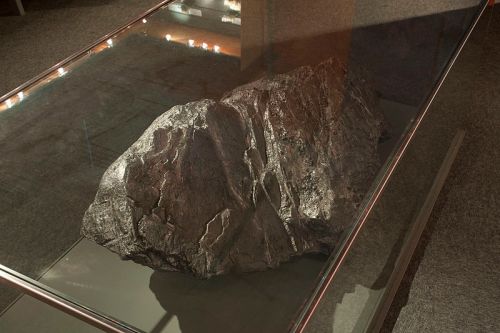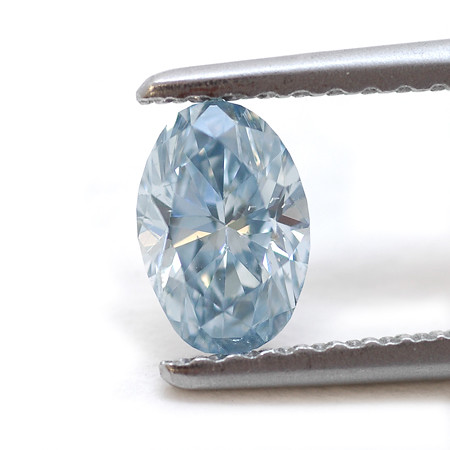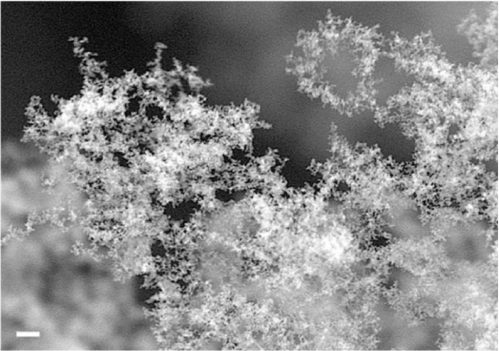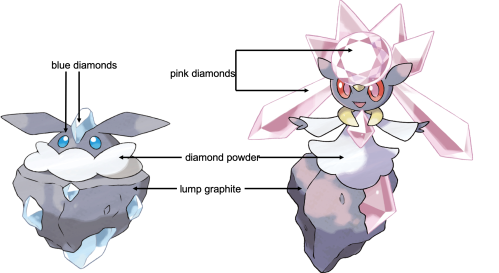For our Halloween blog post back in 2017, I used chemistry to figure out how many moles of gas are in a Gastly, a gaseous ghost/poison-type Pokémon. (Because Pokémon are fantastical creatures, it’s no surprise than many are either inspired by chemistry or can be understood through the lens of chemistry.) Today, as the world’s foremost writer on the chemistry of Pokémon (to my knowledge), I want to dig into the chemistry of two Generation 6 species: Carbink and Diancie. Carbink and Diancie are both classified as Rock and Fairy type Pokémon and are listed as “Jewel Pokémon.”
So where is the chemistry in these two? It all starts with those classifications of “Rock” and “Jewel.” Rocks and jewels are both everyday words we use to describe minerals or crystals. And as we’ve discussed on the blog before (e.g. here), crystals are just regularly-ordered arrangements of atoms!

Let’s start with Carbink! As their English name suggests, Carbink is inspired by the chemical element Carbon. Fun fact: other languages also use names for this particular Pokémon that reference rocks, stones, carats, and diamonds. For example, if you boot up your Nintendo 3DS in French, Carbink will be called Strassie, referencing Strass, a type of rhinestone named after French jeweler Georg Freidrich Strass.
For the sake of this exercise, I will assume that Carbink is primarily carbon. (Technically, so is every other animal, but this is a little magical rock, so probably tons of carbon!) Carbon is one of the most versatile elements and has many forms. An allotrope is a form of a pure element that has a particular structure. Typically, this structure yields significantly different properties. For example, phosphorus has different colors depending on which structure (allotrope) is present.

For carbon, you may be familiar with diamonds and graphite – they’re both pure carbon but one is highly valued and the other is very cheap! (We have a whole blog post on the atomic differences between diamonds and graphite.) Because Carbink is a carbon-based jewel Pokémon with a heterogenous (mixed) structure in their body, I suspect they might include many different allotropes of carbon. (I don’t think I’m too far off on this – there is even a Carbink named Allotrope in the Pokémon animated series.)
So let’s dig in to the biology (geology?) of Carbink:

Carbink has four main features: 1) grey rock-like subtstance 2) light blue crystals 3) bright blue eyes and 4) a soft white fluffy mane. Going with the assumption that Carbink is carbon-themed, I’m going to suggest some allotropes and other carbon-based materials that might make up its body.
Let’s start with the grey rock-like substance. To me, that looks like it might be graphite.

Graphite is a common allotrope of carbon and very abundant. It comes in many different forms, the most familiar for most people being the “lead” inside most pencils! The Pokémon game information about Carbink is consistent with this idea: one Pokémon game, Sun, tells us that Carbink is “Born from the high temperatures and pressures deep underground.” This means that our Carbink is probably lump graphite, which is formed in high temperature conditions underground.
Now what’s up with those blue crystals? They aren’t bright white like our standard image of diamonds. When thinking of blue gemstones you might remember sapphire, but sapphire is actually corundum or aluminum oxide, and we’ve established that we’re working with mostly carbon. So, are there blue diamonds?

There are – and they are mostly carbon but the blue color is due to contamination of boron in the diamond, or little borons hanging out in the crystal where carbons should be. Still, all diamonds regardless of color are primarily carbon. Diamond coloration can vary in intensity though, so we can assume that the light blue crystals and the dark blue crystal-ish eyes on Carbink are both blue diamonds of varying quality and intensity. (I will not try to explain how this creature could see with diamond eyes, however.)

Finally, we’re faced with figuring out what that fluffy white mane is. This is a little bit harder. Most carbon allotropes are crystalline. Very few are fluffy. I’ve hunted through common and obscure allotropes and I’ve found very limited options. One possibility is carbon nanofoams (these deserve a blog post all on their own, but you can read more about aerogels here). While carbon nanofoams are light and reportedly fluffy, they’re actually black in color like soot.1 I’ve considered carbon based compounds like cellulose, but these aren’t technically allotropes because they are not pure carbon. Plus, cellulose is found in plants and isn’t crystalline – it’s unlikely to be a product of the high temperature and pressure underground that formed Carbink. So, I think to stay on theme I’m going to posit that the white fluffy mane that Carbink peeks at us from behind is actually also diamonds!

While most of us think of dramatic, large jewel diamonds when we consider this allotrope, the fact is most diamonds are what would be considered “low quality” as gemstones. They’re still useful, though! Diamond powder – which can range from white to grey – is a fluffy powder made of extremely small, low quality diamonds. It is used for polishing items, including other jewels. Perhaps Carbink uses its mane to shine and groom its other diamond inclusions.
Many Pokémon have “evolutions” (where they change from one form to another after becoming stronger) but Carbink doesn’t. However, there is a Pokémon that seems very related to Carbink – Diancie! Diancie is also carbon themed but, as their name suggests, with more of a focus on diamonds. Occasionally, according to Pokémon lore, a Carbink will mutate into a Diancie (though you can’t control this in the game). So what’s up with Diancie’s biology?

Overall, Diancie has features similar to Carbink. I suspect the grey rock-like substance is still lump graphite, and that their white shirt is some sort of powdered diamond construction. However, in place of blue diamonds, they have pink diamonds and many more jewels in their bodies than Carbink. As I mentioned, Carbink’s blue diamond hue is due to boron inclusions (similarly, yellow diamonds are caused by nitrogen in the crystal lattice). But pink diamonds are a bit more complicated.
Unlike blue or yellow diamonds, a pink diamond’s color isn’t due to some other contaminating element but due to the high pressure of their natural synthesis. This pressure might change the crystal lattice, and therefore change the color we observe! We’ve talked a lot on the blog about how changes in nano-scale crystal structures can affect the colors we see (for example here and here); perhaps this process of pink diamond coloration relates to Diancie’s mysterious mutated origin!
So, based on all our knowledge of carbon allotropes, we can relabel these little mysterious Pokémon this way:

While this is not an exhaustive investigation of carbon allotropes by any means, I believe that we can combine chemistry, mineralogy, some etymology, and a dash of imagination to help find connections between the grounded (pun intended) world of science and our most fantastical passtimes like Pokémon. And connecting Pokémon with science is not just a silly, fun thought experiment (though it certainly is that). Research on memory and learning3 (as well as anecdotal evidence!) suggests that knowing something about the taxonomy and characteristics of Pokémon could actually make it easier to learn and remember related information about chemistry; and vice versa! So next time you hear about diamond, graphite, or carbon allotropes, just remember this lesson on the differences between Carbink and Diancie.

More on rocks & minerals from Sustainable Nano
- Interstellar Carbon Nanoparticles: From Dull to Shiny
- Kids Learn About Nanodiamonds and I Learn About Kids
- Nuclear Proliferation & Sustainability: the History of Nanodiamonds
- It’s National Chemistry Week! (“Chemistry Rocks” theme)
REFERENCES
- Salleh, A. Crazy carbon nanofoam loves magnets. ABC Science, March 25, 2004.
- Rode, A. et al. Structural analysis of a carbon foam formed by high pulse-rate laser ablation. Applied Physics A. 69 [Supplemental], S755-S758. doi: 10.1007/s003399900355
- Sutton, J. Scaffolding memory: Themes, taxonomies, puzzles. In Stone & Bietti (eds) Contextualizing Human Memory: An interdisciplinary approach to understanding how individuals and groups remember the past. Taylor & Francis, 2015. doi: 10.4324/9781315815398
